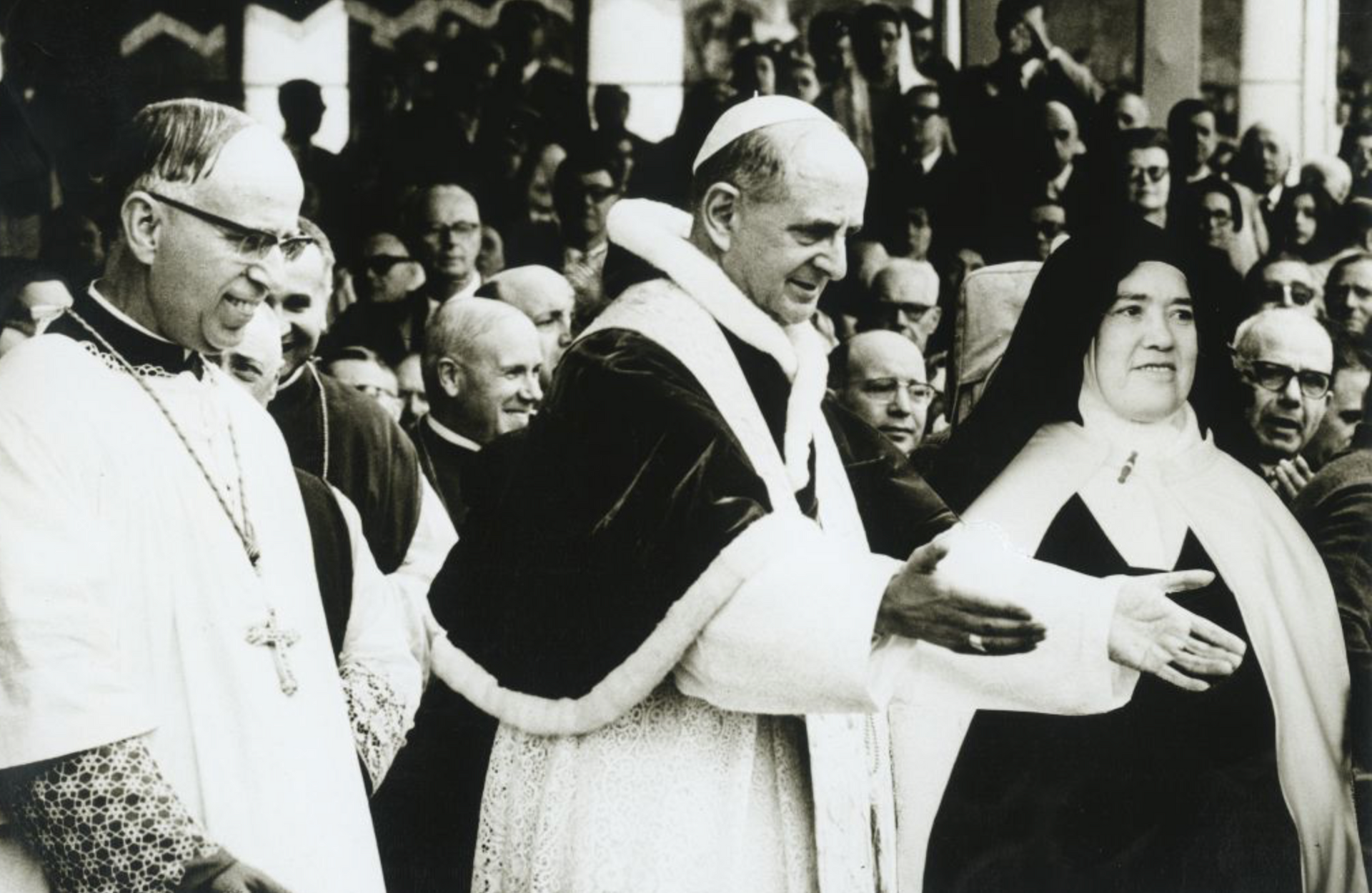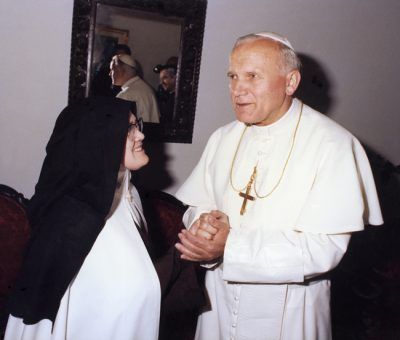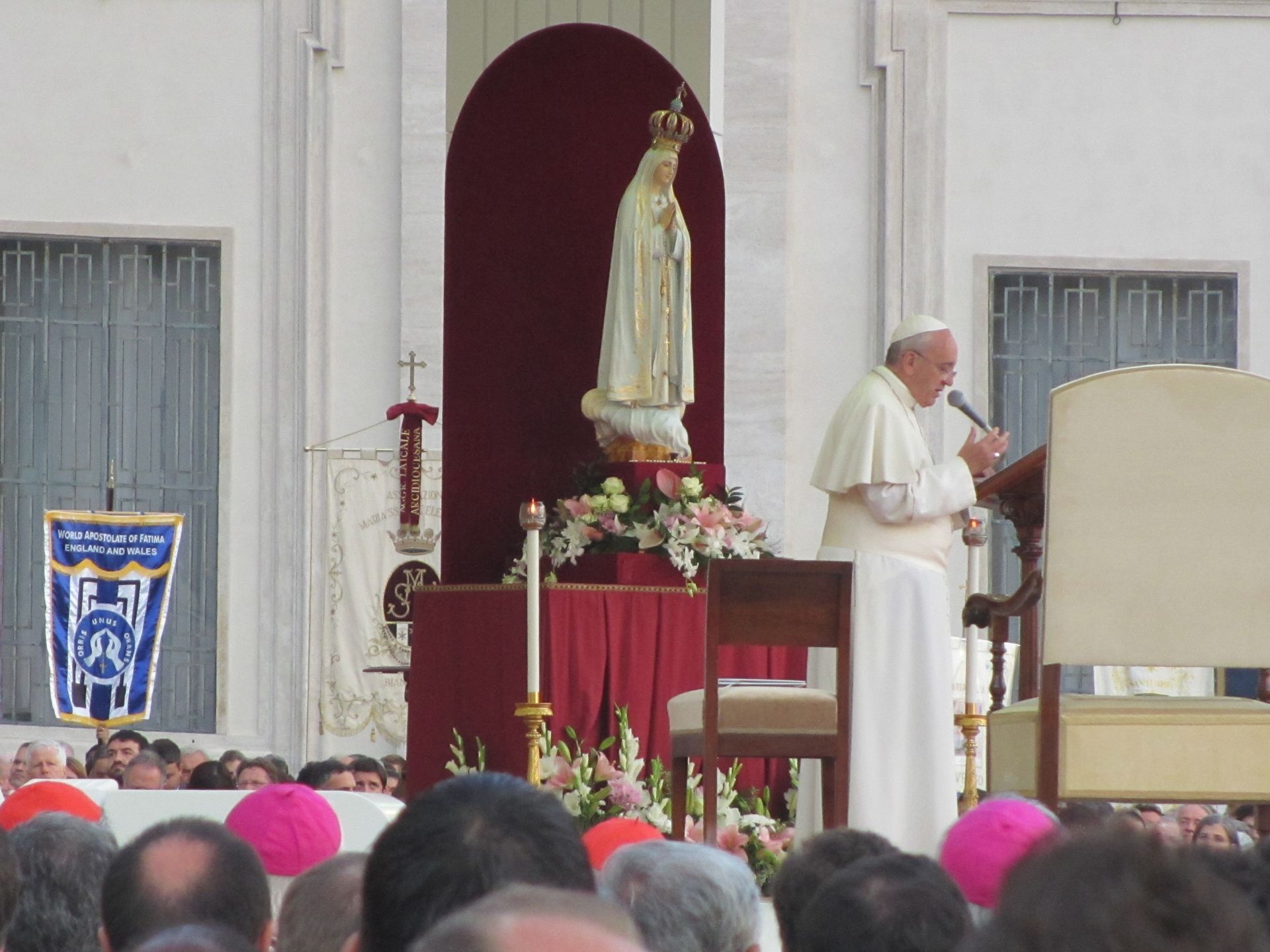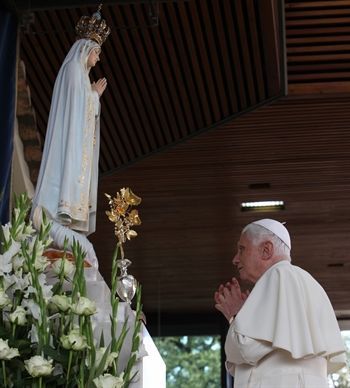Fatima and the Catholic Church
The third part of the Fatima secret
Pope John Paul II announced at Fatima on 13 May 2000 that the text of the third part of the secret of Fatima would be released by the Congregation for the Doctrine of the Faith “after the preparation of an appropriate commentary [and] in order that the faithful may better receive the message of Fatima”.
In announcing its forthcoming publication at the direction of St John Paul II, Cardinal Sodano said that it concerned “above all the war waged by atheistic systems against the Church … the immense suffering endured by witnesses of the faith … an interminable Way of the Cross led by the Popes of the 20th century”.
Sr Lucia describes how in the vision they saw a bishop dressed in white, which she understood was the Holy Father, with clerics and religious, passing through a half ruined city and going up a steep mountain “at the top of which there was a big Cross of rough-hewn trunks”. The Pope prayed for the dead on his way there, much afflicted and moving slowly, and was killed at the top by soldiers, as were the clerics, religious and lay people with him.
On 26 June 2000, Cardinal Ratzinger, later Pope Benedict XVI, published the full text of the third part of the secret, together with his own Theological Commentary, with many important insights into its meaning and significance for the Church. This was issued in a 21-page document entitled The Message of Fatima, which also contained a quantity of supporting documentation. On the same day it was made immediately available on the Vatican website, where it can be read at:
https://www.vatican.va/roman_curia/congregations/cfaith/documents/rc_con_cfaith_doc_20000626_message-fatima_en.html
Sr Lucia later affirmed, when she was shown the hand-written text of the vision, that she recognised it as the one she had written down in 1944, and contrary to some erroneous allegations, that that was the complete text of the vision, and there were no further secrets to be revealed.
Also, in her third memoir, she tells us about two incidents in which Jacinta saw visions of a future Pope, and these also relate to the secret.
One day, while they were near the well at Lucia’s home, Jacinta asked her if she had seen the Holy Father. When Lucia replied, “No,” Jacinta said: “I don’t know how it was, but I saw the Holy Father in a very big house, kneeling by a table, with his head buried in his hands, and he was weeping. Outside the house, there were many people. Some of them were throwing stones; others were cursing him and using bad language. Poor Holy Father, we must pray very much for him.”
Sr Lucia then tells us: “At another time, we went to the cave called Lapa do Cabeço. As soon as we got there, we prostrated on the ground, saying the prayers the Angel had taught us. After some time, Jacinta stood up and called to me: ‘Can’t you see all those highways and roads and fields full of people, who are crying with hunger and have nothing to eat? And the Holy Father in a church praying before the Immaculate Heart of Mary? And so many people praying with him?’ Some days later, she asked me: ‘Can I say that I saw the Holy Father and all those people?’ ‘No. Don’t you see that that’s part of the secret? If you do, they’ll find out right away.’ ”
During his homily at the Mass for the beatification of Francisco and Jacinta at Fatima on 13 May 2000, St John Paul II expressed his personal gratitude to Blessed Jacinta for the sacrifices and prayers she had offered for the Holy Father, “whom she saw suffering greatly”.
This is how Sr Lucia described the vision that she saw in the third part of the secret:
“After the two parts which I have already explained, at the left of Our Lady and a little above, we saw an Angel with a flaming sword in his left hand; flashing, it gave out flames that looked as though they would set the world on fire; but they died out in contact with the splendour that Our Lady radiated towards him from her right hand: pointing to the earth with his right hand, the Angel cried out in a loud voice: ‘Penance, Penance, Penance!’. And we saw in an immense light that is God: ‘something similar to how people appear in a mirror when they pass in front of it’
“a Bishop dressed in White ‘we had the impression that it was the Holy Father’. Other Bishops, Priests, men and women Religious going up a steep mountain, at the top of which there was a big Cross of rough-hewn trunks as of a cork-tree with the bark; before reaching there the Holy Father passed through a big city half in ruins and half trembling with halting step, afflicted with pain and sorrow, he prayed for the souls of the corpses he met on his way; having reached the top of the mountain, on his knees at the foot of the big Cross he was killed by a group of soldiers who fired bullets and arrows at him, and in the same way there died one after another the other Bishops, Priests, men and women Religious, and various lay people of different ranks and positions. Beneath the two arms of the Cross there were two Angels each with a crystal aspersorium in his hand, in which they gathered up the blood of the Martyrs and with it sprinkled the souls that were making their way to God.”
THE CONSECRATION OF RUSSIA
On 13th July 1917, Our Lady announced: “I shall come to ask for the consecration of Russia to my Immaculate Heart”. This was fulfilled when Sr Lucia saw a vision of the Most Holy Trinity with Our Lady, on 13 June 1929, as she was making a Holy Hour in the convent chapel at Tuy in Spain. Lucia tells us that: “Suddenly the whole chapel was illumined by a supernatural light, and above the altar appeared a Cross of light, reaching to the ceiling. In a brighter light on the upper part of the Cross, could be seen the face of a man and his body as far as the waist; upon his breast was a dove of light; nailed to the Cross was the body of another man. A little below the waist, I could see a chalice and a large Host suspended in the air, onto which drops of blood were falling from the face of Jesus Crucified and from the wound in His side.”
These drops ran down the host and into the chalice. Beneath the right arm of the Cross was Our Lady and in her hand was her Immaculate Heart. (It was Our Lady of Fatima, with her Immaculate Heart in her left hand, without sword or roses, but with a crown of thorns and flames). Under the left arm of the Cross, large letters, as if of crystal clear water which ran down onto the altar, formed these words: ‘Grace and Mercy’.
I understood that it was the mystery of the Most Holy Trinity which was shown to me … Our Lady then said to me:
“The moment has come in which God asks the Holy Father, in union with all the Bishops of the world, to make the consecration of Russia to my Immaculate Heart, promising to save it by this means. There are so many souls whom the Justice of God condemns for sins committed against me, that I have come to ask reparation: sacrifice yourself for this intention and pray.”
The Collegial Consecration explained
1942 - Pius XII was the first pope to consecrate the world in October 1942
Pius XII was the first pope to consecrate the world, in October 1942, and then Russia, in July 1952, to Mary’s immaculate Heart. However, St John Paul II became the first Pope to fulfil Our Lady’s request for the consecration of Russia, on 25th March 1984, which led seven years later to the collapse of Communism in Eastern Europe and the peaceful dissolution of the Soviet Union.
1984 - St John Paul II's consecration of Russia accepted in Heaven
St John Paul II became the first Pope to fulfil Our Lady’s request for the consecration of Russia, on 25th March 1984, which led seven years later to the collapse of Communism in Eastern Europe and the peaceful dissolution of the Soviet Union
St John Paul II’s consecration was accepted in heaven, as Sr Lucia subsequently testified on several occasions, because the Pope was “in union with all the bishops of the world”, exactly as Our Lady had requested. On that occasion, all the bishops of the world had received the text of the Pope’s act of consecration in advance, together with his invitation for them to join with him in making the act.
Following this consecration, Sr. Lucia was visited by the Apostolic Nuncio, and she confirmed that the consecration of Russia had indeed been accomplished, and that God had accepted it.
Within one years of the pope’s consecration, changes began peacefully within the Soviet Union. In Russia, on the death of Chernenko, on 11 March 1985, Mikhail Gorbachev became General Secretary of the Communist Party. In 1986, Gorbachev initiated the programmes of perestroika (restructuring), and glasnost (openness), which led to the process of democratisation and the thaw in attitudes towards religion in 1987. He became President in 1988.
Following this consecration, Sr. Lucia was visited by the Apostolic Nuncio, and she confirmed that the consecration of Russia had indeed been accomplished, and that God had accepted it.
Within one years of the pope’s consecration, changes began peacefully within the Soviet Union. In Russia, on the death of Chernenko, on 11 March 1985, Mikhail Gorbachev became General Secretary of the Communist Party. In 1986, Gorbachev initiated the programmes of perestroika (restructuring), and glasnost (openness), which led to the process of democratisation and the thaw in attitudes towards religion in 1987. He became President in 1988.
1989 - Poland, Hungary,Berlin and the Soviet Union - key movements
Around 15 August 1989, the Solemnity of the Assumption, Poland moved towards a government led by non-Communists.
On 7 October 1989, the Feast of the Holy Rosary, the Hungarian Communist Party voted to transform itself into a form of European democratic socialism.
On 9 November 1989, the Berlin Wall came down. The fall of the “Iron Curtain” was an event that many in the West never expected to see in their lifetime.
On 1 December 1989, at his historic meeting with Pope John Paul II at the Vatican, Gorbachev promised that a Law on the Freedom of Conscience would soon be adopted in the Soviet Union. The Holy Father referred to this meeting as a “sign of the times … a sign that is rich in promise.” The Pope said “our meeting had been prepared by Providence”.
1990 - Further developments - Soviet Union and Poland
On 15 March 1990, the Vatican established diplomatic relations with the Soviet Union.
In May 1990, Bishop Amaral of Leiria-Fatima said: “Everything leads us to think that the consecration requested by Our Lady has been done.”
On 11 November 1990, when Bishop Angelo Kin of the Korean Episcopal Conference said to the Pope that it was thanks to him that Poland had been freed from Communism, Pope John Paul II said: “No, not me, but by the works of the Blessed Virgin, in line with her affirmations at Fatima.”
1991- The Soviet Union becomes Russia freeing 15 republics
On 8 December 1991, the feast of the Immaculate Conception marked the start of the Commonwealth of Republics, the end of the Soviet Union. Twelve days later, the newly named President of Russia, Boris Yeltsin, met with the Pope in Rome.
On Christmas Day, 1991, the Communist flag came down for the last time over the former Soviet Union and in Soviet embassies around the world, and the Russian parliament voted to change the country’s name to the Russian Federation, abbreviated simply as Russia. On December 30th, fifteen republics were freed from Soviet domination as the Warsaw Pact ended.
The following are the most significant consequences that have flowed from St John Paul II’s fulfilment of Our Lady’s request for the consecration of Russia:
– the cessation of the Marxist-atheist persecution of religion and the consequent freedom for people of all faiths to practise their religion, and for the Russian Orthodox Church to undertake a massive programme of reconstruction and refurbishment of churches that had been vandalised and destroyed.
– the lifting of the very real threat of a war with nuclear armaments provoked by the massive Soviet military machine, and the ensuing peace that has prevailed in Europe.
– the freedom of former Soviet countries in Eastern Europe to join the European Union.
The supreme sign that all this extraordinary change was a result of the unseen intercession of the Immaculate Heart of Our Lady of Fatima is surely the fact that the world’s second greatest military superpower at that time—which had President Reagan of the USA and Prime Minister Margaret Thatcher of Great Britain seriously concerned about the West’s capability to defend itself from attack—decreed itself out of existence, by a process that was almost entirely peaceful, and which arose from within. No other reason has hitherto been advanced to explain how such an unprecedented change could have come about.
Sr Lucia on the consecration of Russia – Statements by Sr Lucia that Pope John Paul II’s act of consecration of Russia, on 25 March 1984, was “accepted by heaven”, and confirmed by an apparition of the Virgin.
FATIMA AFTER THE APPARITIONS
Meanwhile, work on the construction of the Capelinha, the Chapel of Apparitions, began on 28 April 1919 and was completed on 15 June; the first Mass was celebrated there on 13 October 1921. The pedestal on which the image of Our Lady stands in the Capelinha marks the exact spot where the little holm oak grew on which Our Lady appeared. In May 1922, Bishop Jose Correia da Silva of Leiria-Fatima, named a commission of enquiry to analyse the facts surrounding the Fatima phenomenon “with strictness and impartiality”.
On 10 December 1925, Sr Lucia, who had become a postulant with the Dorothean Sisters, was at their convent in Pontevedra, Spain, when she saw another apparition, this time of Mary with the Child Jesus. Mary told Lucia that she promised all the graces necessary for salvation to those who, on the first Saturday of five consecutive months, confessed, received Holy Communion, recited five decades of the rosary, and meditated on the rosary for fifteen minutes, all with the intention of making reparation to her Immaculate Heart.
Meanwhile, on 13 January 1924, Mass was celebrated for the first time inside the Capelinha, while on 26 June 1927, the bishop presided for the first time at an official event—the inauguration of the 14 kilometre Way of the Cross to the Cova da Iria, where he celebrated Mass in the presence of 400 pilgrims. Building work on he Basilica of Our Lady of the Rosary of Fatima was begun in 1928, and it was consecrated on 7 October 1953. It has 15 altars dedicated to the 15 mysteries of the Rosary. The bodies of Jacinta and Francisco were moved to their present positions, to the left and right of the main altar, in the early 1950s, and Sr Lucia’s body was interred in the Basilica in 2008 next to Jacinta’s. The mortal remains of Bishop Correia da Silva, who died in 1957, are interred in the Chancel.
Prior to this, on 13 June 1929 Sr. Lucia, while at prayer in the convent chapel at Tuy, saw a vision of the Most Holy Trinity, with Mary standing on the altar displaying her Immaculate Heart in her left hand. It was on this occasion that Mary asked the Pope, in union with all the bishops of the world, to make the [collegial] consecration of Russia to her Immaculate Heart that she had announced during the July 1917 apparition.
On 13 October 1930 the Bishop issued a pastoral letter on the apparitions, which, after recounting the events at Fatima, contained the following brief but important statement:
“In virtue of considerations made known, and others which for reasons of brevity we omit; humbly invoking the Divine Spirit and placing ourselves under the protection of the most Holy Virgin, and after hearing the opinions of our Rev. Advisors in this diocese, we hereby:
- Declare worthy of belief, the visions of the shepherd children in the Cova da Iria, parish ofFatima, in this diocese, from the 13th May to13th October, 1917.
- Permit officially the cult of Our Lady of Fatima.”
In thanksgiving for this development, six months later, on 13 May 1931, a vast pilgrimage of around 300,000 people came to Fatima to participate in a ceremony presided over by Cardinal Cerejeira, Patriarch of Lisbon, at which all the bishops of Portugal made the first consecration of their country. It was this consecration, and that of 1938, which preserved Portugal from the violent attack on the Church in the Spanish Civil War, and its renewal in 1940 saved Portugal from being dragged into the horrors of the Second World War.
Fatima developments from World War II onwards
On 31 October 1942, during World War II, Pope Pius XII, speaking in Portuguese by radio, consecrated the world to the Immaculate Heart of Mary, with a special mention of Russia, in response to the request he had received in a letter from Sr Lucia. Some months later Sr Lucia said that as a result of this act, God promised to end the war soon.
On 13 May 1946, Cardinal Masella, the Papal Legate, crowned the Statue of Our Lady of Fatima in the Capelinha as Queen of Peace. This crown was made from gold melted down from wedding rings donated by the women of Portugal, and it also contains over 4,000 precious stones, which they contributed in thanksgiving for Portugal having been spared the horrors of the Spanish Civil War and the Second World War.
On 13 October 1951, Cardinal Tedeschini, who was in Fatima for the closing of the Holy Year, revealed that in October 1950, at the time when he had promulgated the dogma of Mary’s Assumption into heaven, Pope Pius XII had witnessed a repetition of the solar miracle of 13 October 1917, while he was walking in the Vatican gardens.
Cardinal Roncalli, the Patriarch of Venice, and the future Pope John XXIII, presided at the ceremonies at Fatima on 13 May 1956, while, on 21 November 1964, Pope Paul VI, at the conclusion of the third session of the Second Vatican Council, proclaimed “the Most Blessed Mary Mother of the Church”; the Pope also considered it was “particularly opportune” to recall Pius XII’s consecration of the world to the Immaculate Heart of Mary; and bearing that consecration in mind, he announced before the 2,500 Council Fathers, that a Golden Rose was to be presented to the Sanctuary of Fatima (this act was carried out on 13 May 1965 by Cardinal Cento, the Papal Legate); and the Pope concluded his address by proclaiming, “to your Immaculate Heart, O Mary, we commend the entire human race”.
Pope Paul VI came to Fatima on 13 May 1967 to celebrate the 50th anniversary of Our Lady’s first Apparition, and to pray for world peace and Church unity. In a significant sign of papal approval for the message of Fatima, the Pope invited Sr Lucia to join him on the external altar in front of the crowds, and in his Apostolic Exhortation Signum Magnum, issued on the same day, Paul VI urged “all members of the Church to consecrate themselves once again to the Immaculate Heart of Mary and to translate this pious act into their daily lives”.
Ten years later, on 10 August 1977, the future Pope John Paul I, Cardinal Luciani, Patriarch of Venice, came on pilgrimage to Fatima.
UK HEADQUARTERS
World Apostolate of Fatima
Headquarters
International UK phone
Email:
Skype
PARISH ACTIVITIES





